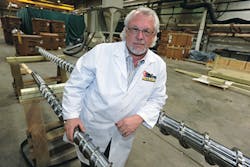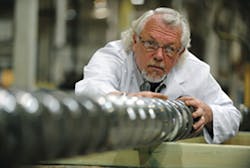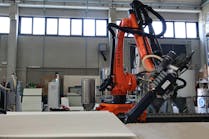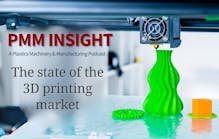
With thousands of screw designs to his credit, Timothy W. Womer is still going strong in a career that spans more than 40 years. He is the president of TWWomer & Associates LLC, an Edinburg, Pa., consulting company he began in 1998. He holds numerous patents on screws and screw mixers.
Womer, who is a past president of the Society of Plastics Engineers, was elected to the Plastics Hall of Fame in 2012. He recently spoke with PMM senior correspondent John DeGaspari.
Tell me about growing up. What were you interested in?
Womer: I grew up in western Pennsylvania, north of Pittsburgh, on a small farm. When you grow up in the country, you learn to do a lot of things, drive a tractor, plow the fields. I grew up in the Amish region halfway between New Wilmington and a little village called Volant.
I learned how to weld when I was young; I took machine shop in high school. The business my dad was in was called Suburban Floor and Tile; he installed carpet and linoleum, ceramic tile and marble. I was always really hands-on. I started working for my dad when I was 7 years old, and by the time I was 12 years old, I was doing installations.
What led you to choose engineering as a career?
Womer: I went to Penn State Shenango Valley Campus in Sharon, Pa., for two years, and I came out of there with an associate's degree in mechanical engineering technology. I had three interviews. One was at Newport News Shipbuilding, one was at Procter & Gamble and one was with New Castle Industries Inc. Tanner Plating Division, which made rolls for all the steel mills in Youngstown [Ohio] and Pittsburgh.
New Castle offered me $700 a month. They hired me as a draftsman to help design heat-transfer rolls. I joined the union's shop-training program and started in the chrome shop as a plater's helper. An opening came up in the sandblast shop, which was how they cleaned the rolls before they put them in the tank — I spent about three months at that. I then was assigned to the machine shop.
I applied for a draftsman position at New Castle's feed-screw facility and was told, "We will give you the job under one condition: You have to go back to college and get your four-year engineering degree, but we'll pay you for it." That's how I got my engineering degree. I went back to Youngstown State University, because Youngstown was closer and they actually had a four-year degree program at night. So I ended up getting my bachelor's degree in applied science, with a major in mechanical engineering technology. I finished up when I was 26.
After earning your four-year degree, how did your career progress?
Womer: My supervisor retired about six months after I had graduated from YSU, and they went out and interviewed for a new engineering supervisor. At that time I was making about $22,000 a year and they saw that if they would have to hire somebody new, they were going to have to pay $30,000 or $35,000 for an engineering supervisor. So [they said] "Let's give Tim another $2,000 and let him be the engineering supervisor."
Six months after the engineering supervisor retired, the vice president of engineering, who hired me back in 1974, was getting ready to retire. They interviewed for that position, and they found out that they would have to pay at the time, like, $40,000 or $50,000. So they said, "Let's give Tim another $2,000 and we'll make him engineering manager." So, at 28 years old, I was engineering manager for a $15 million company.
After about 15 years at New Castle, I knew that it was time to move on, and that's when I went to NRM [Corp.] That was where I learned about capital equipment, building extruders and sheet lines and pipe and profile lines. When I started at NRM, I was just a process engineer, responsible for extrusion, because that's what I wanted to do. I really started understanding screw design.
Then, in 1992, I went to Conair Corp. in Franklin, Pa. When I was at Conair, I was a manager of systems engineering. Being a screw designer, I knew exactly what materials and throughput rates were on typical-size extruders, so we knew what size equipment to quote. That was a good steppingstone. Then I went to Spirex, and founder and President Paul Colby Sr. was probably the best boss I ever had. Paul was an entrepreneur. He hired me as his director of R&D, to build a brand-new lab with injection molding and extrusion in it.
In my career, I have been involved in the manufacture of close to a quarter of a million screws. When I was with Xaloy, which had bought New Castle Industries in 2003, we would design between 70 and 80 new screws a month.
What is it about screw design that clicked with you?
Womer: Screw design fascinated me. That's where I started really asserting myself. Doing an apprenticeship on the floor: I do not know of another screw designer — there are only a handful, literally four or five in the United States — who has ever taken a bar of steel off the rack, sawed it, turned it, milled it, polished it, welded it. I'm a journeyman machinist. I have a metal lathe and a Bridgeport mill in my garage, two welders and cutting torches. I still practice the trade I learned 45 years ago. I have designed thousands of screws. Either I designed them personally or my department designed them. For some reason, God just gave me a talent, this ability to understand how plastic melts. I just envision plastic pellets going in at the throat, going through the melt phase, and then being pumped out and then going through a die or into a mold.
Who were some of your mentors at SPE?
Womer: One of the guys who was really out there was Bruce Maddock; I met him when I was younger and I was really impressed with the work that he was doing at Union Carbide Corp. Then, I met Bob Barr and met some of the others, like George Kruder and Bob Gregory and all of these old-time guys. They were the godfathers of screw design and really understood it.
One of my great mentors, and he is still living, is Earl Veazey; he worked for Dow Chemical in Freeport, Texas. He got me involved in SPE in the extrusion division. Early on, he said, "Tim, if you learn to be a translator, an interpreter, where you can understand the theories that the Ph.D.'s are telling, and translate it so that you can take it to the shop floor, where the money is made, you will find a place in this industry that nobody else can match." It was great advice.
Where do you come up with the ideas for the patents?
Womer: My first patent I filed when I was with Spirex Corp. In their office, they had notebook after notebook of patents. I started reading them, and thought it would be interesting to be an inventor. Everything is relative to something, in some way or form. I've designed screws for injection molding, blow molding and all types of extrusion processes and things that happen in extrusion sometimes are applicable to what happens in injection molding. So, many times it is just understanding the entire process and applying what you learn from one application and make it work for another application.
What do you see as the most exciting innovations in the plastics industry?
Womer: 3-D printing. Local Motors was the first to 3-D print a car at the International Manufacturing Technology Show in 2014 in Chicago; and then at the last NPE show, Sabic had the blue Shelby Cobra in their booth. Working with Oak Ridge National Laboratory and Cincinnati Inc. on the first 3-D Big Area Additive Manufacturing Machine, I designed the melting devices to allow them to extrude large amounts of polymer.
3-D printing is something that really interests me; I know I can help. You've got to grab onto a technology that you are comfortable with and familiar with so you can contribute to it. Injection molding, blow molding and thermoforming are not going to go away. But in the area of prototyping and low-volumes, less than 1,000 parts, there are going to be 3-D printing companies producing complex parts when small quantities are required.
How do you want to be remembered?
Womer: What you see is what you get. I don't have an agenda. I love to teach. If I can teach someone something that I know, then my job becomes easier. The more knowledgeable I can make my customer, the easier my job becomes, because now I can go out and do something different and something new. There are not enough young people coming up behind us older guys, so we have to start mentoring younger people.
I think a lot of it goes back to having great parents, and a father who taught me good work ethics. You reap what you sow.








